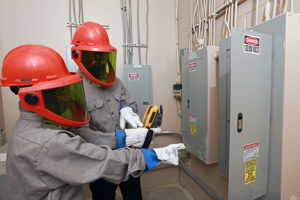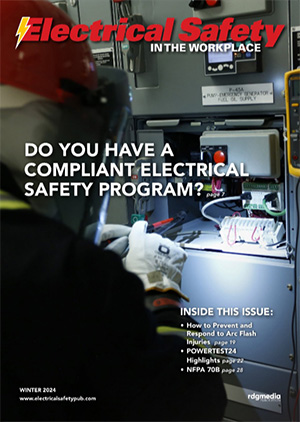Six Keys to NFPA 70E® Training
By Jay Smith, Contributor
 NFPA 70E® training teaches you how the standard’s life-saving work practices help avoid electrical injuries, deaths, and OSHA violations. Training covers many topics, including establishing electrically safe work conditions, elements of a risk assessment, the difference between electrical hazards and risks, and the intent and limitations of personal protective equipment (PPE) required by 70E. Here are six key training considerations to address:
NFPA 70E® training teaches you how the standard’s life-saving work practices help avoid electrical injuries, deaths, and OSHA violations. Training covers many topics, including establishing electrically safe work conditions, elements of a risk assessment, the difference between electrical hazards and risks, and the intent and limitations of personal protective equipment (PPE) required by 70E. Here are six key training considerations to address:
-
The changing workforce
A number of facility maintenance crews are bleeding knowledge—about facilities, hazards, electrical equipment—as the workforce ages with waves of retirements. This heightens the importance of NFPA 70E training for younger generations of workers who have not witnessed the evolution of electrical safety and arc flash safety in particular. Only in the past 15 years or so, since 2005-2006, when OSHA started citing companies for arc flash accidents, has arc flash knowledge and protections gained traction.
Older workers have seen an arc flash, been shocked, escaped near misses. They have decades of on-the-job knowledge, including identifying hazards and making hazard assessments.
Electrical safety training for newer workers should be led by instructors who can relate personal stories, accidents and close calls, case studies to bring 70E requirements to life. That dose of reality won’t come from viewing slide in a PowerPoint or a video. It helps to be trained by someone who have been there, done that, and likely scarred along the way.
-
Arc flash causes
A key point in 70E training is explaining how an arc flash occurs, and its causes. There are usually two main contributing factors. Either equipment has failed, or there is a physical interaction with an energized piece of equipment, such as removing a panel and working with a circuit breaker. Other causes include human error, failing to use insulated tools, excessive dust, corrosion, improperly maintained or installed switches and circuit breakers, use of substandard parts, and condensation near electrical equipment. Arc flash temperatures can reach as high as 35,000°F, hotter than the surface of the sun.
-
Equipment with arc flash potential
Another key learning in 70E training cover the types of equipment with arc flash potential. Safety issues are raised whenever personnel work with an overcurrent protective device, such as circuit breakers or fuses. These devices protect against the potentially dangerous effects of overcurrents, such as an overload current or a short-circuit current, which creates a fault current. In general, an arc flash assessment or arc flash hazard study / analysis should be performed on equipment at 50 V or higher. The IEEE 1584 standard is also used for guidance on the types of equipment with arc flash potential. Opinions vary on the equipment capable of producing an arc flash, but safe to say we’re not talking about a light switch or an electrical outlet.
-
Protection before an arc flash assessment has been performed
What should be done if an arc flash assessment hasn’t been performed? An arc flash risk assessment is a process to determine the level of hazard that exists at each electrical enclosure, such as a control panel, panelboard, disconnect switch or switchgear. Outside providers like SEAM Group can perform Arc Flash Risk Assessments to identify and document potential arc flash hazards for all facilities with three-phase electrical power systems, which is required by NFPA 70E. This standard covers every type of commercial, industrial and institutional facility. 70E training offers guidance on recommended levels of personal protective equipment (PPE) matched to equipment types, voltages, and tasks to be performed. For example, PPE should be worn at all times when working in the facility, and 40 cal suits should be work for higher potential exposures. A bit of guesswork is involved until the arc flash assessment has been conducted.
-
Understanding arc flash labeling
Assessment findings lead to applying arc flash labels on equipment and learning how to read data on the labels is another key point in 70E training. Labeling is required for any piece of electrical equipment that may need examination, adjustment, service or maintenance while energized, creating the potential for an arc flash incident to occur. At a minimum, NFPA 70E labels must contain the nominal system voltage, the arc flash boundary, and one of the following: the available incident energy and the corresponding working distance or the arc flash PPE category found in the NFPA 70E PPE category tables, the minimum arc rating of clothing, or the site-specific level of PPE. Electrical workers need to understand approach boundaries for both arc and shock hazards, how it affects the work of the person performing the diagnostics, as well as the risk to nearby coworkers, not only on the same level, but working above or below the task at hand.
-
Meter use documented training
One more point relating to 70E training: the standard requires qualified employees to have documented training on how to use a meter and how to interpret all indications coming from the metering device. This documentation is often overlooked in a qualified person program. Your qualified workers must be hands-on trained on using a meter and reading interpretations. Meter readings can vary greatly depending on where the meter is placed, such as if you’re testing a 480 system, a phase to phase or phase to ground procedure.
These six points are often overlooked when deciphering NFPA 70E® requirements and setting the parameters for your training. The changing workforce and new adult learning styles must be taken in account. Arc flash is a lethal hazard and understanding arc flash causes should be at the forefront of training. Not often covered, though it should be, are the types of equipment that can produce an arc flash. Also often not cover in training is what to do for protection before an arc flash hazard assessment is performed. Arc flash labeling can be filled with details, small print, and deserves special attention in training because understanding labels can be a life saver. Finally, all your training should be documented. Document everything, including meter use by a qualified person. ESW
Jay Smith is the Director – Electrical Safety Services, SEAM Group (www.seamgroup.com).
Share on Socials!
Infrared Technology
Your First Aid Kit Is (Probably) Outdated!
Arc Flash Analysis: A Project Overview for Electrical Contractors
Leaders in Electrical Safety
• Aramark
• Bowtie Engineering
• Enespro
• Ericson
• I-Gard Corporation
• IRISS
• KERMEL, INC.
• Lakeland Industries
• MELTRIC Corporation
• National Safety Apparel
• National Technology Transfer
• Oberon
• Saf-T-Gard
• SEAM Group
Subscribe!
Sign up to receive our industry publications for FREE!







